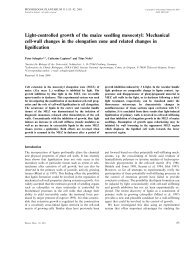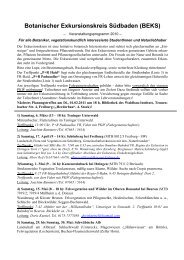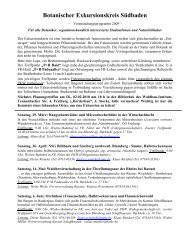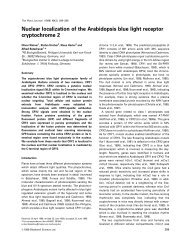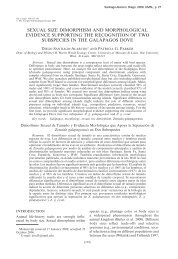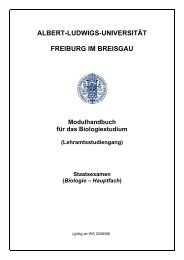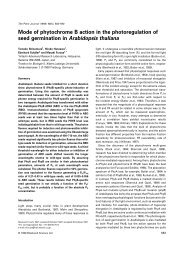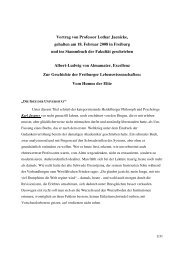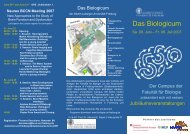download - Fakultät für Biologie - Albert-Ludwigs-Universität Freiburg
download - Fakultät für Biologie - Albert-Ludwigs-Universität Freiburg
download - Fakultät für Biologie - Albert-Ludwigs-Universität Freiburg
Erfolgreiche ePaper selbst erstellen
Machen Sie aus Ihren PDF Publikationen ein blätterbares Flipbook mit unserer einzigartigen Google optimierten e-Paper Software.
Poster - Ludemann<br />
Kiln site anthracology and fuel wood ecology in western Central Europe<br />
THOMAS LUDEMANN<br />
University of <strong>Freiburg</strong>, Faculty of Biology, Dept. of Geobotany<br />
Schaenzlestrasse 1, D-79104 <strong>Freiburg</strong>, Germany<br />
thomas.ludemann@biologie.uni-freiburg.de<br />
Selected anthracological studies in Central Europe are highlighted, with special regard to historical<br />
sites of charcoal burning. The main topic is how analyses of archaeological macrocharcoals from kiln<br />
sites (kiln site anthracology) can provide answers to questions of vegetation history and vegetation<br />
ecology at the landscape level (fuel wood ecology). In Central Europe remnants of tradional charcoal<br />
burning are widespread. Thousands of kiln sites are known. Their analysis offers us unique<br />
possibilities to gain results with fine spatial resolution (regional to local), providing new and<br />
unexpected results for vegetation science.<br />
Examples are given of a diversified pilot area, with special regard to the natural diversity of growth<br />
conditions and forest vegetation. It includes the Black Forest, the Vosges and neighbouring regions.<br />
Generally, no selection of distinct wood species was made for charcoal production. All of the tree taxa<br />
to be expected for the natural conditions were exploited in the past and the frequencies of the taxa<br />
exploited often reflect a natural situation. The tree species of the climax vegetation were mainly used<br />
and all other species were quantitatively unimportant. The individual kiln sites show considerable<br />
differences in tree taxa composition and frequency, from which regular spatial patterns of the past tree<br />
species distribution have been inferred. These patterns can be explained by regional and local<br />
differences in the ecological site conditions of the exploited forests. A pronounced dependency of the<br />
fuel wood use on the natural distribution of the tree species is discernible. The local natural offering of<br />
wood and the restricted possibilities of wood transport were important criteria for past fuel wood<br />
exploitation.<br />
References<br />
LUDEMANN, T. (2010): Past fuel wood exploitation and natural forest vegetation in the Black Forest,<br />
the Vosges and neighbouring regions in western Central Europe. – Palaeogeogr. Palaeoclimatol.<br />
Palaeoecol. 291 (1/2): 154–165. doi:10.1016/j.palaeo.2009.09.013 (2009)<br />
LUDEMANN, T. (2010): Kiln site anthracology and fuel wood ecology in western Central Europe. – In:<br />
ANREITER, P. et al. (eds.): Mining in European history and its impact on environment and human<br />
societies: 209–213.<br />
LUDEMANN, T. (2007): Das Abbild der natürlichen Vegetation in der historischen Holznutzung.<br />
Synthese anthrakologischer Studien im Mittelgebirgsraum Zentraleuropas. - Ber. d. Reinh.-Tüxen-<br />
Ges. 19: 7-22.<br />
LUDEMANN, T. (2003): Large-scale reconstruction of ancient forest vegetation by anthracology – a<br />
contribution from the Black Forest. – Phytocoenologia 33 (4): 645-666.<br />
LUDEMANN, T. (1994): Vegetations- und Landschaftswandel im Schwarzwald unter anthropogenem<br />
Einfluß. – Ber. d. Reinh.-Tüxen-Ges. 6: 7–39.<br />
27



